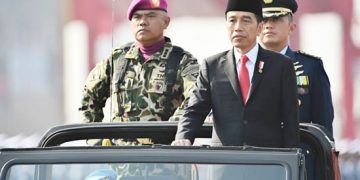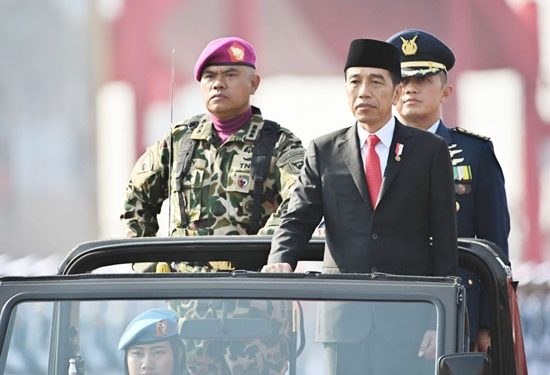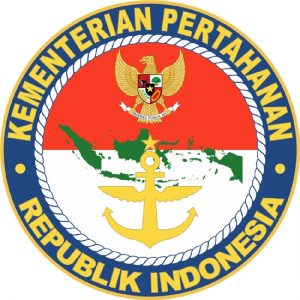Dr. Mehmood Ul Hassan
Director: Geopolitics/ Economics Regional Expert: Indonesia & ASEAN
Complex and complicated geopolitical scenarios and rapidly changing geostrategic orientation of axis of partnerships has now changed the geography of Asia and Indo-pacific regions. Due to which regional countries have been revisiting its socio-economic propositions, geopolitical engagements and last but not least, geostrategic partnerships accordingly and the Republic of Indonesia is not any exception. It has already redesigned, reshaped, reorganized, regrouped and revisited its foreign as well as defence policies.
Indonesia’s strategic location connects the sea and air routes between East Asia and the Middle East and between Australia and Asia enhances its importance in international relations. Thus its defence policy is unique and multidimensional.
In this connection, it derived its defence policy from the Total People’s Defense and Security System (Sishankamrata) which is indeed a mandate of the 1945 Constitution specifically Article 30 paragraph 2, which further elaborates that “The defense and security of the state is undertaken through a total people’s defense and security system with the Indonesian Military and the Indonesian National Police the main elements of force, and the entire people as the supporting element.”
It is evident that Sishankamrata is based on the mobilization of all national resources, namely the armed forces and the people, to defend Indonesia from any threats and to advance its national interests. It draws its roots from three core values, namely kerakyatan (people-centered), kewilayahan (territorial-based) and kesemestaan (totality).
In addition to this the value of “people-centered” upholds the importance of people at the heart of national defense thus it is people’s centric national security. The value of “territorial-based” showcases the comprehensive preparedness of a self-reliant territorial defense posture in accordance with the distinct features of each territory. Last but not the least, the value of “totality” pinpoints the integration and unity of efforts across all national defense components in defending the nation-state against any military, nonmilitary or hybrid threats. Thus it is people’s centric, holistic, comprehensive, integrative, collaborative, innovative and futuristic too.
It seems that the Sishankamrata has multidimensional values which are operationalized and channelized through a layered-defense and defense-in-depth strategy that is comprised on the Mandala, or concentric circle, concept, where the innermost circle comprises Indonesia’s land territories up to the territorial sea; the inner circle spans from the territorial sea up to the exclusive economic zone (EEZ); and the outermost circle is the territory beyond the EEZ.
These ideas place Sishankamrata as a strategic defense concept that re-shapes Indonesia defence orientation, mobilization of its national resources to achieve its national defense and security objectives in a given strategic environment, especially the 21st century Indo-Pacific regional dynamics.
It is reality that Indonesia’s current military capability against an external threat is primarily focused against a threat from the north and its capabilities are modest which should be rectified by giving priority to internal security.
Indonesia national defence is based on a Total Defence System (TDS) to achieve its national goals. The system is essentially a defence policy involving all citizens in accordance with their roles and functions. The involvement of every citizen in national defence is in-line-with the 1945 Constitution of the Republic of Indonesia. A State Defence Program, or defined as Bela Negara program, is implemented within the next decade and expected to reach 100 million citizens who are militant. This program will continually develop the needs of national defence.
Interestingly, Indonesia is the largest archipelagic state, located between two oceans (Pacific Ocean and Indies Ocean) and two continents (Asia continent and Australia continent). Its strategic location caused Indonesia facing many disputes and threats from neighboring states around Indonesian Archipelagic Sea Lanes (Alur Laut Kepulauan Indonesia (ALKI)).
Indonesian Archipelagic Sea Lanes itself is a sea lanes that traversed by ships or foreign aircraft above the groove, to implement shipping and aviation in the normal mode solely for transit continuous, direct, and as soon as possible and not be deterred by or on over the archipelagic waters and the adjacent territorial sea between one part of the high seas or the Indonesian exclusive economic zone and on the high seas or other Indonesian Exclusive Economic Zone (EEZ).
Indonesia has also a doctrine of defense that contain in the Indonesia Defense White Paper. It is a road map for Indonesian armed forces to prepare a comprehensive strategy. Indonesia’s defense is arranged in a total defense system in order to achieve national goals that list in preamble of 1945 Constitution of the Republic of Indonesia. The TDS is established to integrate military defense and non-military defense, through efforts to build strength and national defense capability that is strong and respected and has a high deterrent power.
Furthermore, Indonesia’s defense posture consists of active personnel, paramilitary personnel, and reserve personnel. It consists of the Army (TNI-AD), Navy (TNI-AL), and Air Force (TNI-AU). The President of Indonesia is the commander-in-chief of the Armed Forces. In 2021, it comprises approximately 395,500 military personnel including the Indonesian Marine Corps (Korps Marinir RI), which is a branch of the Navy. In Army, there is 13 military area command (KODAM). In Navy, there are two fleets: Western Fleet (KOARMABAR) and Eastern Fleet (KOARMATIM). In Air Force, there are two operational commands: West Command and East Command.
Moreover, Indonesian naval western fleet based is based on Jakarta and Indonesian naval eastern fleet is based on Surabaya. Indonesian Navy has military equipment such as 2 Cakra tactical attack submarine with ASW capability, 11 frigates (6 Ahmad Yani, 1 Ki Hajar Dewantara, 4 Diponegoro), 88 patrol and coastal combatants (21 corvettes, 24 patrol crafts, 43 coastal boats), 11 mine warfare (2 ocean mine countermeasure, 9 coastal mine sweepers), Amphibious (5 LPD, 21 LST, 55 landing crafts), 32 logistic and support, 23 maritime patrol aircraft, 36 light transport aircraft, 4 maritime reconnaissance helicopters, 15 transport helicopter.
With the U.S.-China rivalry in Southeast Asia intensifying in recent years, the South China Sea has become a significant arena for strategic competition between the two great powers. As tensions over territorial disputes continue to destabilize the region, geopolitics has become more complex.
Since the outbreak of the Covid-19 pandemic, every country has struggled to cope with the virus’s impact, including in the defense domain and same is the case of Indonesia. Therefore, recalibrating defense diplomacy has become urgent for ASEAN countries and especially Indonesia to adapt to the “new normal” in a post-pandemic world.
Indonesia’s defense strategy supports its defense diplomacy which is critical for fostering mutual and peaceful relations with international partners, including both China and the United States.
In this regard, the Indo-Pacific region has always been an integral part in Indonesia’s defence policy. The interest on the Indo-Pacific region was also presented in Indonesia’s Defence White Paper 2015 as it mentioned that the Asia-Pacific’s rapid development requires certain observations as it will be the area where US-China have clashing interests.
Indonesian Defence Minister Prabowo Subianto had to resolve many issues mainly rebuilding the Indonesian defense industry; accelerating the Minimum Essential Force (MEF) program; managing the Defense Ministry’s tenuous relationship with the Indonesian National Armed Forces (TNI); completing unfinished defense-related laws; and rejuvenating civil-military relations. However, his ministerial portfolio extends beyond just domestic problems to encompass regional and international challenges and his integrated defence diplomacy is seemingly on the right path to create strategic cushion between the two super powers.
It is evident that fighter jet diplomacy has been a salient feature of Prabowo’s defense diplomacy, such as the commitment to South Korea’s KF-X Joint Development fighter program, the Sukhoi from Russia, the Eurofighter Tycoon from Austria, and the F-16 from the United States.
It seems that Prabowo diversified defence policy especially arms procurement supplies of chain is well devised policy due to which hopefully, Indonesia will not be dependent on any single arms supplier, considering the past U.S. arms embargo toward Indonesia.
Indonesia’s key role as a middle power is also important for its contribution to the solution of global challenges. Prabowo’s defense diplomacy is a balancing effort amid the growing great power contest, a diversification of security and defense partnerships that also manifests Indonesia’s traditional preference for a “free and active” (bebas-aktif) foreign policy.
Indonesia’s global defense orientation would seek friendly relations with other regional countries as well as international states in support of a defensive military strategy. Prabowo’s diplomatic maneuvering has indeed enhanced Indonesia’s non-aligned stance: with many defense partners, Indonesia will not be trapped into one or a group of military suppliers. Now hopefully, the advancement of security cooperation will also drive more chances for a greater diplomatic, political, and economic partnership with these nations. Thus Prabowo’s defense diplomacy should be in coordination of Indonesia’s overall foreign policy strategy.
In this connection, in the near past, Prabowo and Indonesian Foreign Minister Retno Marsudi have converged their principal stances on several regional issues. One such occasion was the recent 2+2 meeting with their Japanese counterparts, when the two ministers seemed aligned in their priorities for bilateral cooperation with Tokyo. Both high officials/policy makers rightly focused on a coherent commitment to building more vigorous economic and maritime defense collaboration.
Indonesia has sever reservations about the Australia, UK and USA security deal and termed it security threat which would start another arms race and power projection in the region and beyond thus marginalized socio-economic prospects.
The foreign ministry also urged respect for the United Nations Convention on the Law of the Sea, which governs navigation through international waters. Deputy Foreign Affairs Minister Mahendra Siregar said Indonesia was “worried” that Australia’s acquisition of nuclear submarines would spur an arms race and regional instability.
Pakistan, ASEAN and especially Indonesia have made remarkable progress in counter terrorism and Counter-Violence Extremism (CVE) and in promoting peace and security in the region. Both sides have concussed over global and regional security, terrorism, narcotics, maritime security, and human trafficking.
Moreover, both sides have also achieved notable developments such as Joint Defence Cooperation Committee (JDCC) Army to Army and Navy to Navy talks, joint professional training courses, bilateral visits of top level defence officials and active participation of the Indonesian navy in AMAN joint naval exercises in Pakistan. In the near past, Indonesia-Pakistan joint Navy exercise named Sea Thunder IV was held at Karachi during 2019.
To conclude, the Indonesian armed forces are strongly committed to play their constructive role at the national, regional and international level for peace and stability among the people and the nations.








